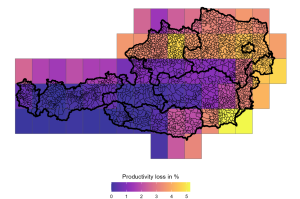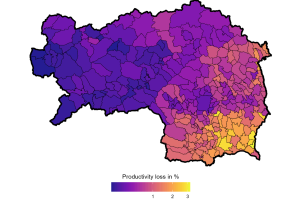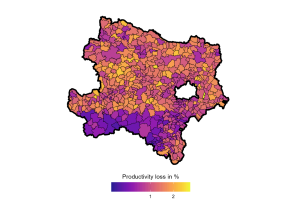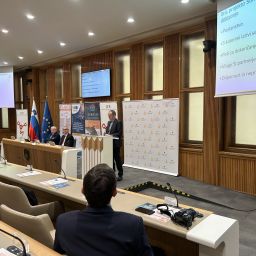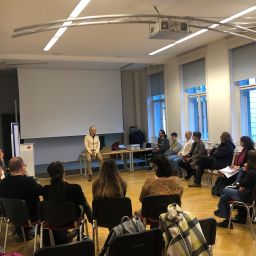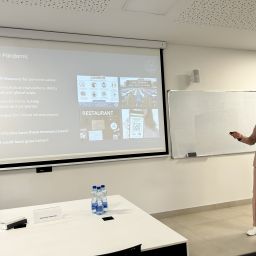
SUNRISE CRITICAL INFRASTRUCTURE SERIES
Effects of heat on labour productivity in Austria
The latest report by the Intergovernmental Panel for Climate Change (IPCC) from 2023 shows that limiting global warming to (below) 2°C is very difficult to achieve and that even an ambitious climate policy is likely to lead to higher temperatures.[1] A study by Geosphere Austria shows that heatwaves in Austria are already occurring 50% more frequently compared to the period 1961 to 1990 and are also lasting longer.[2] Rising temperatures are reflected among others in economic effects like crop failures, agriculture drought, or winter tourism decline. However, some economic sectors will be particularly affected by the impact of higher temperatures on people. The Institute for Advanced Studies (IHS) is investigating the future consequences of rising temperatures for labour productivity in Austria and the resulting economic effects.
Depending on the severity of the physical work and the climatic conditions, people’s performance and therefore also their labour productivity decreases above a certain temperature rise [3]. To avoid (serious) damage to health, working hours in conditions characterised by extreme heat should be reduced. The National Institute for Occupational Safety and Health (NIOSH) has published limit values for temperatures in the workplace and a correspondingly recommended reduction in working hours for the categories “light/moderate/heavy physical work” and differentiated according to whether this is carried out “indoor/outdoor”. The Wet-Bulb Globe Temperature (WBGT) is an extension of regular temperature measurements and integrates factors such as humidity, wind speed and radiant heat, which are decisive for labour productivity.
Accordingly, economic sectors that involve more physically strenuous work that also might be carried out in the sun, such as agriculture, construction, or certain industrial sectors, are most affected by heat. The lowest productivity losses are to be found in the service sectors, where mainly mental or physically light work is carried out, which increasingly also takes place in air-conditioned rooms. However, higher temperatures, especially during heatwaves in summer, affect the general well-being of people in all areas of work, so persistently high temperatures in combination with hot nights can also lead to additional labour productivity losses not evaluated in this study.
ClimateChip uses the recommended guideline values for the reduction in working hours together with selected case studies and links them to regional temperature forecasts based on two current climate models and the “Shared Socioeconomic Pathway 370 (SSP3-7.0)” scenario presented by the IPCC. This allows regional productivity losses for the standardised categories of working conditions “light/moderate/heavy work” and “indoor/outdoor” to be retrieved for the periods 2011-2040, 2041-2070 and 2071-2100.
Figure 1 shows the average effect on labour productivity for heavy outdoor work in summer (Q3) by region based on the projected scenario-based average WBGT increases for the period 2041-2070. Due to their geographical location and high soil sealing, federal states north of the Alps and in the southeast are affected by productivity losses of up to 5% and more due to heat, in contrast to inner-Alpine areas.
The economic effects of productivity losses for a region depend not only on the expected climate changes but also on the regional economic structure. At 6.3%, urban centres in Austria have a lower percentage of jobs in severely affected economic sectors and are therefore also less affected in percentage terms. In absolute terms, however, the number of jobs affected, particularly in the construction sector, is high. In rural areas, the proportion of industrial sectors affected by heat is almost three times as high as in urban centres and affects around a quarter of jobs in relation to the place of work.
A look at the average regional productivity losses shows that rural areas in Lower Austria and the south of Styria will be particularly affected by the higher temperatures and the high proportion of physically demanding jobs in exposed sectors of the economy. In some regions, an average annual decline in labour productivity of 3% in the summer quarter is to be expected (see Figures 3 and 4). However, the consequences for urban centres should not be underestimated due to the high number of jobs and higher economic output. In addition, urban centres may be more severely affected by the effects of urban heat islands than predicted in the climate models due to the high level of soil sealing.
Figure 2 shows the annual average productivity losses taking into account all labour intensities by municipality in Styria for the period 2041-2070.
Figure 3 shows the average productivity losses by municipality in Lower Austria for the period 2041-2070.
As shown here, the climate crisis affects people’s ability to work under corresponding climatic conditions. In this article, only the direct effects of heat on the decline in labour productivity in Austria were considered, without taking into account the consequences for the national economy. Similarly, the many other consequences for society and the general well-being of people, which will also have an impact on the world of work (such as loss of biodiversity, extreme weather events and natural disasters or changes in the tourism sector) were not considered.
Written by: Christian Kimmich , Elisabeth Laa , Hannes Zenz , Leonhard Ulrici (Institute for Advanced Studies (IHS)
[1] IPCC AR6 Working Group 1: Summary for Policymakers | Climate Change 2021: The Physical Science Basis
[2] https://www.zamg.ac.at/cms/de/klima/news/hitzewellen-laenger-und-haeufiger
[3] Kjellstrom, T., Briggs, D., Freyberg, C., Lemke, B., Otto, M., & Hyatt, O. (2016). Heat, Human Performance, and Occupational Health: A Key Issue for the Assessment of Global Climate Change Impacts. Annual review of public health, 37, 97–112. https://doi.org/10.1146/annurev-publhealth-032315-021740


